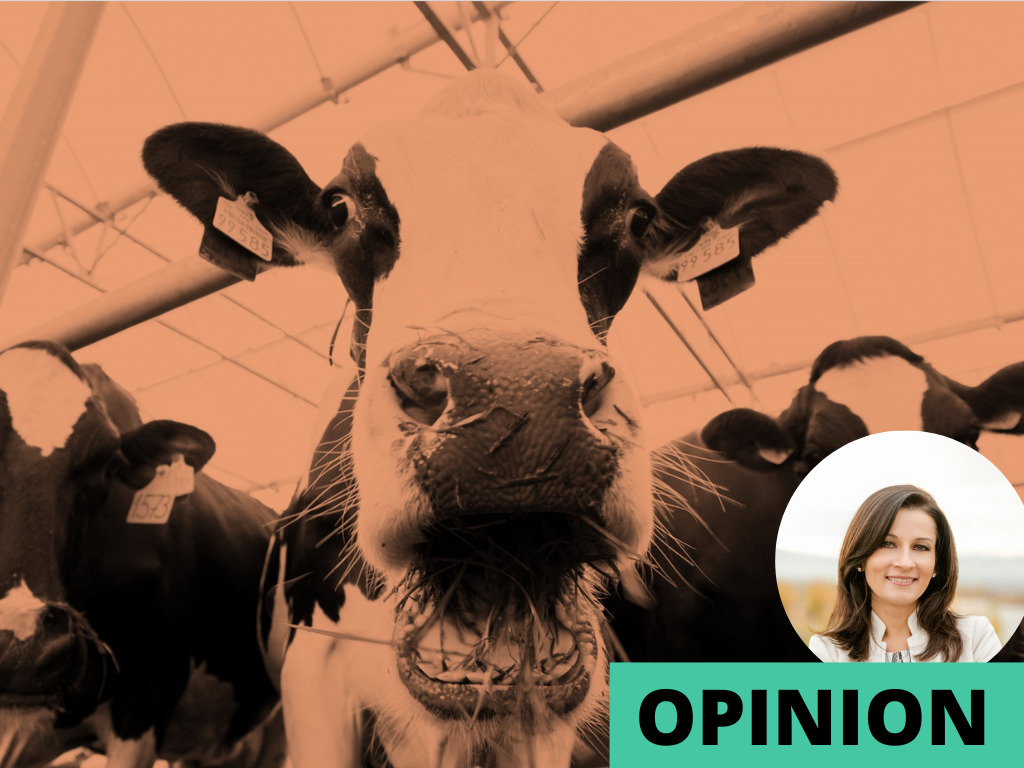5 Mins Read
Notes From the Frontlines of the Sustainable Food Movement – a new opinion column by Irina Gerry
There has been a lot of chatter lately about “Low Carbon Beef”, but does the climate math hold up?
The United States Department of Agriculture (USDA) recently approved Low Carbon Beef label, which can now be placed on meat products in the US in order to differentiate this “more sustainably farmed beef” from conventional options, as well as to justify higher price premiums. To qualify for the label, cattle farmers must demonstrate at least 10% lower greenhouse gas emissions than the industry standard baselines. Sounds nice, right?
Except, there is a problem with that. On average, producing 1kg of beef emits about 100kg of CO2e, which is by far the highest emissions of any food.
For perspective, producing 1kg of chicken emits about 10kg of CO2e and 1kg of peas comes in at just 1kg of CO2e. That’s 100 times less.

So, does a 10% reduction make a meaningful difference to warrant the Low Carbon Beef label? Absolutely not.
This is the cattle industry’s attempt to respond to consumer concerns around beef’s climate footprint, as more and more consumers seek to align their climate concerns with their food purchases. It is a pure form of greenwashing.
At scale, animal agriculture today is responsible for 14.5% of global GHG emissions, with cattle representing a 65% share.
While politicians avoid any conversation about reducing meat consumption like a plague, considering it a political non-starter, there are a number of initiatives underway that attempt to reduce the climate footprint of cattle. According to UN FAO, several ways of reducing emissions from livestock include:
- Improving feed quality, precision feeding and methane-reducing additives (seaweed feed additives only reduce cattle methane emissions by about 9%, while adding potential ecological impact of large-scale algae farming, which is far from the panacea it is hyped up to be)
- Animal genetics, breeding and animal health (cows that grow faster, cow vaccines)
- Intensifying recycling efforts (ag waste products as feed) and minimizing losses for a circular bioeconomy (manure as fertilizer, manure as biogas)
- Capitalizing on nature-based solutions to ramp up carbon offsets (soil carbon sequestration through regenerative grazing)
However, even if we deploy all available strategies to reduce livestock emissions, we only get to a 30% reduction.
We still end up with 70kgs CO2e per 1kg of beef, on average, which is still far higher than any other food.
There is no such as thing as Low Carbon Beef, only Reduced Carbon Beef, if you like.
While regenerative grazing advocates fervently defend beef, professing it to be the “climate savior” and even calling for grazing more cattle than we do today as a way to restore degraded soils, the reality on the ground remains starkly different from the future that “could be”. Regenerative grazing holds a promise of carbon sequestration by implementing adaptive multi-paddock (AMP) grazing practices as a way to offset cattle emissions with soil carbon sequestration, however most studies presented to support the argument consist of small scale experiments with inconsistent methods and findings, with little consensus on net climate benefit among high quality peer-reviewed research after decades of experimentation and a lot of doubt about the scalability, durability and the magnitude of soil carbon sequestration of such systems outside of highly specific conditions.
Most regenerative grazing benefits tend to focus on converting previously degraded croplands to pasture, which do show a temporary improvement in soil carbon sequestration during the conversion process. However, many such studies lack proper control variables of converting the same degraded lands to forests, wetlands or orchards, and reintroducing wildlife instead of farmed cattle, or applying other regenerative agriculture practices such as reduced tilling and cover crop rotations.
Even the poster child of multi-species pasture rotations, White Oaks Pastures, can only sequester enough carbon in soil to create a greenhouse gas footprint that is 66% lower carbon footprint over conventional commodity beef, while requiring 2.5 times more land and costing 70% more (price per pound of ground beef before shipping). Don’t get me wrong, a 66% emissions reduction is commendable, and the overall system appears to be more resilient, while providing the farmers higher income, but it does not make it Low Carbon.
In general, as unsavory as feedlots may be to those of us who care about animal welfare, industrialized systems tend to be more efficient at converting animals to food products. Regenerative grazing advocates find themselves between the rock and a hard place in trying to promote a more sustainable and kinder food system, while contending with immense resources required to produce cattle-based products, no matter the method. On one hand trying to farm animals in a way more consistent with natural grazing does sound appealing, on the other hand grass-finished beef requires 40-150% more land, increases enteric fermentation related methane emissions by 43% (cows eating grass on pasture emit more methane compared to feedlot cows on a grain diet) and produces 30% less meat as system (grass-finished beef takes longer to grow). Organic and regeneratively grazed beef does not fare much better. Given the increased land and resource requirements of the animal-based system that already occupies 77% of all agricultural land, a transition to regenerative grazing only works if we are willing to eat much less beef and are prepared to pay more for it.
Does it mean we can’t eat beef?
Not necessarily. I know most people simply won’t accept it, no matter the cost. There is also some argument in favor of limited regenerative grazing of cows to restore some of the degraded soils. Further, farmed animals play a crucial role in some of the poorest countries, providing income and serving as a key source of nutrition for smallholder farmers. A 100% cow-free world is neither possible, nor necessary for us to build a sustainable and equitable food system.
My hope is that a clear understanding of the environmental impact would lead most of us who care about the future of our planet to significantly reduce our beef consumption (to the tune of 50-80% in developed countries) and if we do choose to eat it occasionally, choose the “better farmed” option. Because with the growing global population and projected increase in meat demand, we have no hope of meeting the +1.5C degree global warming targets if we stay with the status quo.
Lead image courtesy of Canva.





